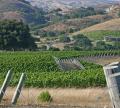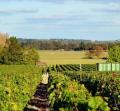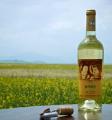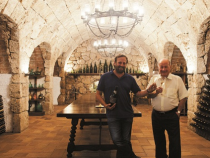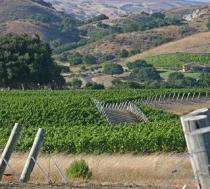Winery Birgit Braunstein & Martin Pasler
时间:2012-12-26 11:00:58 阅读:1181
It is not only tradition, it is passion, it is conviction, it is the belief in herself with which many years ago Birgit Braunstein took over the wine-growing business of her family of more than 400 years of wine-growing tradition. 4000 years in close cooperation with nature in Burgenland, a unique landscape on Lake Neusiedl. Lake Neusiedl has been a UNESCO World Cultural Heritage since 13 December 2001. Thus the region shares a mutual heritage with 721 sites worldwide and a common heritage with history, the present day and the future for all of humanity. .jpg) In 1996 Birgit Braunstein vinified her first wine and found with it, as she says “a moment of real happiness in her life”. To be able to communicate her happiness further, she has placed an Irish four-leaf clover on her etiquettes. Two united “B”s is also a sign for Birgit Braunstein and eternity.Terroir The view wanders to the south, to Lake Neusiedl. Lake Neusiedl, a steppe lake, which calculated according to its surface, is the third-largest lake in central Europe. A special feature is the broad belt of reeds that at certain points extends for some kilometres into the lake. The lake is not only a water reservoir, but also – and its most important role – a climatic regulator. Due to this, for example, the vegetation period of the vines is lengthened so that the grapes reach the optimum physiological maturity, which means a balanced and tightly knit tannin structure for the grapes, a long phenolic chain and balanced acidity content, the basis for elegance in wine. A further factor for the balance of the grapes is the formation of the “cold lake” in the night. Cooler air that rises up from the lake to the vineyard slopes to the forest crest regenerates the temperature in the grapes, an indicator for fruit, aromas and finesse. The view wanders to the north, to the Leitha Range, the last foothills of the Alps. The “Leithaberge” as they are also known colloquially, run from the Brucker Pforte in the north to the Wiener Neustädter Pforte in the south to a length of 35 kilometres and a width of five to seven kilometres. The origins of the Leitha Range was conform to the origins of the Alps, as massive shifts of the earth’s crust that brought about the creation of the range. A striking characteristic of the Leitha Range is the unique soil structure, which is dominant in the core of gneiss and mica slate. The shell-limestone, which is especially well known for its purity, and is also known as “Leithakalk” lies above. Marl, clay and also layers of the crystalline cores form the surface. These are the prerequisites for wines of great character, the vines of which run along the slopes of the range on an area of about 2,000 hectares, and then merge into the protective forests on the mountain crest. This is a further secret of the enormous potential of these wines. It was a potential that the Celts already appreciated and settled in this region, thus making Burgenland one of the oldest wine-growing regions in central Europe. The leaves of the vines sway in the freshening wind. This is essential for cooling the grapes during the hot summer of the Pannonian climate. The Pannonian climate brings a warm spring, a hot and dry summer, a mild, sunny and long-lasting autumn and a cold, damp winter. The transition from winter to the warmer early spring temperatures is heralded by the storks who then return from the south and spend the summer in the idyll of Burgenland before flying away again before the first frosts. When the vine touches the soul Birgit Braunstein has long been occupied with the philosophy of life: where do we come from, where are we going? Like the vines in her vineyards she is deeply rooted in Purbach am Neusiedlersee. The Celts brought winemaking to Burgenland about 3,000 years ago. Old clay pots with grape pips are finds that document history. The names of places and locations are silent witnesses today of this period. A time in which nature defined the rhythm of life. A time in which cellars were built, vines planted and the basis for the traditions of today were created. Traditions that still live today at the Birgit Braunstein wine estate, where the breath of history is still to be felt.
In 1996 Birgit Braunstein vinified her first wine and found with it, as she says “a moment of real happiness in her life”. To be able to communicate her happiness further, she has placed an Irish four-leaf clover on her etiquettes. Two united “B”s is also a sign for Birgit Braunstein and eternity.Terroir The view wanders to the south, to Lake Neusiedl. Lake Neusiedl, a steppe lake, which calculated according to its surface, is the third-largest lake in central Europe. A special feature is the broad belt of reeds that at certain points extends for some kilometres into the lake. The lake is not only a water reservoir, but also – and its most important role – a climatic regulator. Due to this, for example, the vegetation period of the vines is lengthened so that the grapes reach the optimum physiological maturity, which means a balanced and tightly knit tannin structure for the grapes, a long phenolic chain and balanced acidity content, the basis for elegance in wine. A further factor for the balance of the grapes is the formation of the “cold lake” in the night. Cooler air that rises up from the lake to the vineyard slopes to the forest crest regenerates the temperature in the grapes, an indicator for fruit, aromas and finesse. The view wanders to the north, to the Leitha Range, the last foothills of the Alps. The “Leithaberge” as they are also known colloquially, run from the Brucker Pforte in the north to the Wiener Neustädter Pforte in the south to a length of 35 kilometres and a width of five to seven kilometres. The origins of the Leitha Range was conform to the origins of the Alps, as massive shifts of the earth’s crust that brought about the creation of the range. A striking characteristic of the Leitha Range is the unique soil structure, which is dominant in the core of gneiss and mica slate. The shell-limestone, which is especially well known for its purity, and is also known as “Leithakalk” lies above. Marl, clay and also layers of the crystalline cores form the surface. These are the prerequisites for wines of great character, the vines of which run along the slopes of the range on an area of about 2,000 hectares, and then merge into the protective forests on the mountain crest. This is a further secret of the enormous potential of these wines. It was a potential that the Celts already appreciated and settled in this region, thus making Burgenland one of the oldest wine-growing regions in central Europe. The leaves of the vines sway in the freshening wind. This is essential for cooling the grapes during the hot summer of the Pannonian climate. The Pannonian climate brings a warm spring, a hot and dry summer, a mild, sunny and long-lasting autumn and a cold, damp winter. The transition from winter to the warmer early spring temperatures is heralded by the storks who then return from the south and spend the summer in the idyll of Burgenland before flying away again before the first frosts. When the vine touches the soul Birgit Braunstein has long been occupied with the philosophy of life: where do we come from, where are we going? Like the vines in her vineyards she is deeply rooted in Purbach am Neusiedlersee. The Celts brought winemaking to Burgenland about 3,000 years ago. Old clay pots with grape pips are finds that document history. The names of places and locations are silent witnesses today of this period. A time in which nature defined the rhythm of life. A time in which cellars were built, vines planted and the basis for the traditions of today were created. Traditions that still live today at the Birgit Braunstein wine estate, where the breath of history is still to be felt. .jpg) She exercises a great deal of respect for nature and the elements to vinify her wines. She watches over the vines throughout the year with extreme calm and care. She fosters and supports nature at first hand and organically. Gives it the freedom and the time to develop. The philosophy of her wines is the clarity, the Mineralik, the elegance and the profundity. Nature defines the character of her wines. Potential for years to come – created in the vineyard, created for the future, which she will create lastingly, intensively and honestly with all her heart. She is the calm and the energy, the observer and the dynamic, the lightness and the powerful. With all of her ideas and intension, in 2000 she founded “11 Women and their wines 它不仅是传统、激情、信念,比尔吉特·布朗斯坦在自己很多年前接手她的家庭已有400多年的葡萄种植传统的葡萄种植业务。 4000年,在布尔根兰州,Neusiedl湖上一道独特的风景与自然的密切合作。 2001年12月自13日Neusiedl湖已被联合国教科文组织列为世界文化遗产。 因此,该地区与721个世界各地的历史,现在和未来的所有人类的共同遗产与共享一个共同的遗产。 比尔吉特·布朗斯坦在1996年她的第一个葡萄酒酿造,她说:“在她的生活中真正的幸福时刻”。 为了能够进一步沟通她的幸福。” 葡萄树的叶子在清新的微风中摇摆。 潘诺尼亚气候在炎热的夏天用于冷却的葡萄,这是非常重要的。 的潘诺尼亚气候带来了一个温暖如春,夏季炎热干燥,温和,阳光充足和持久的秋天和寒冷,潮湿的冬季。 从冬天过渡到温暖的早春温度预示着鹳,然后从南方回来,在布尔根兰州的田园诗的前度过夏天再次飞行距离第一次霜冻前。 当藤触及灵魂 比尔吉特·布朗斯坦一直被占用的人生哲学:我们在哪里,我们去哪里? 在她的葡萄园的葡萄树一样,她已深深扎根于Purbach镇,坐落上午Neusiedlersee。 凯尔特人带来了酿酒距今约3000年至布尔根兰州。 旧的粘土盆葡萄点数,找到该文件的历史。 的名称,场所,部位,这一时期是沉默的证人。 在这种性质的定义的时间的生活节奏。 酒窖建的时间,葡萄树种植,创建了今天的传统的基础。 传统,今天仍然生活在比尔吉特·布朗斯坦葡萄酒庄园,仍然能够感受到历史的气息。
She exercises a great deal of respect for nature and the elements to vinify her wines. She watches over the vines throughout the year with extreme calm and care. She fosters and supports nature at first hand and organically. Gives it the freedom and the time to develop. The philosophy of her wines is the clarity, the Mineralik, the elegance and the profundity. Nature defines the character of her wines. Potential for years to come – created in the vineyard, created for the future, which she will create lastingly, intensively and honestly with all her heart. She is the calm and the energy, the observer and the dynamic, the lightness and the powerful. With all of her ideas and intension, in 2000 she founded “11 Women and their wines 它不仅是传统、激情、信念,比尔吉特·布朗斯坦在自己很多年前接手她的家庭已有400多年的葡萄种植传统的葡萄种植业务。 4000年,在布尔根兰州,Neusiedl湖上一道独特的风景与自然的密切合作。 2001年12月自13日Neusiedl湖已被联合国教科文组织列为世界文化遗产。 因此,该地区与721个世界各地的历史,现在和未来的所有人类的共同遗产与共享一个共同的遗产。 比尔吉特·布朗斯坦在1996年她的第一个葡萄酒酿造,她说:“在她的生活中真正的幸福时刻”。 为了能够进一步沟通她的幸福。” 葡萄树的叶子在清新的微风中摇摆。 潘诺尼亚气候在炎热的夏天用于冷却的葡萄,这是非常重要的。 的潘诺尼亚气候带来了一个温暖如春,夏季炎热干燥,温和,阳光充足和持久的秋天和寒冷,潮湿的冬季。 从冬天过渡到温暖的早春温度预示着鹳,然后从南方回来,在布尔根兰州的田园诗的前度过夏天再次飞行距离第一次霜冻前。 当藤触及灵魂 比尔吉特·布朗斯坦一直被占用的人生哲学:我们在哪里,我们去哪里? 在她的葡萄园的葡萄树一样,她已深深扎根于Purbach镇,坐落上午Neusiedlersee。 凯尔特人带来了酿酒距今约3000年至布尔根兰州。 旧的粘土盆葡萄点数,找到该文件的历史。 的名称,场所,部位,这一时期是沉默的证人。 在这种性质的定义的时间的生活节奏。 酒窖建的时间,葡萄树种植,创建了今天的传统的基础。 传统,今天仍然生活在比尔吉特·布朗斯坦葡萄酒庄园,仍然能够感受到历史的气息。 .jpg) 她行使了大量的对自然的尊重和的元素,vinify她的葡萄酒。 她看着多棵葡萄树,一年四季极度冷静和谨慎。 她培育和支持的第一手资料和有机的性质。 给它的自由和时间来开发。 她的葡萄酒的优雅清晰度,Mineralik,深刻的哲学。 她的葡萄酒自然定义的字符。 在未来几年的潜在的 - 创造,为未来建立在葡萄园中,她将创造持久,深入和坦诚与她所有的心。 她是平静和能源,观察员和动态,亮度和强大的。 她有思想和内涵,在2000年,她创办了“11名妇女和他们的葡萄酒”协会。
她行使了大量的对自然的尊重和的元素,vinify她的葡萄酒。 她看着多棵葡萄树,一年四季极度冷静和谨慎。 她培育和支持的第一手资料和有机的性质。 给它的自由和时间来开发。 她的葡萄酒的优雅清晰度,Mineralik,深刻的哲学。 她的葡萄酒自然定义的字符。 在未来几年的潜在的 - 创造,为未来建立在葡萄园中,她将创造持久,深入和坦诚与她所有的心。 她是平静和能源,观察员和动态,亮度和强大的。 她有思想和内涵,在2000年,她创办了“11名妇女和他们的葡萄酒”协会。
.jpg) In 1996 Birgit Braunstein vinified her first wine and found with it, as she says “a moment of real happiness in her life”. To be able to communicate her happiness further, she has placed an Irish four-leaf clover on her etiquettes. Two united “B”s is also a sign for Birgit Braunstein and eternity.Terroir The view wanders to the south, to Lake Neusiedl. Lake Neusiedl, a steppe lake, which calculated according to its surface, is the third-largest lake in central Europe. A special feature is the broad belt of reeds that at certain points extends for some kilometres into the lake. The lake is not only a water reservoir, but also – and its most important role – a climatic regulator. Due to this, for example, the vegetation period of the vines is lengthened so that the grapes reach the optimum physiological maturity, which means a balanced and tightly knit tannin structure for the grapes, a long phenolic chain and balanced acidity content, the basis for elegance in wine. A further factor for the balance of the grapes is the formation of the “cold lake” in the night. Cooler air that rises up from the lake to the vineyard slopes to the forest crest regenerates the temperature in the grapes, an indicator for fruit, aromas and finesse. The view wanders to the north, to the Leitha Range, the last foothills of the Alps. The “Leithaberge” as they are also known colloquially, run from the Brucker Pforte in the north to the Wiener Neustädter Pforte in the south to a length of 35 kilometres and a width of five to seven kilometres. The origins of the Leitha Range was conform to the origins of the Alps, as massive shifts of the earth’s crust that brought about the creation of the range. A striking characteristic of the Leitha Range is the unique soil structure, which is dominant in the core of gneiss and mica slate. The shell-limestone, which is especially well known for its purity, and is also known as “Leithakalk” lies above. Marl, clay and also layers of the crystalline cores form the surface. These are the prerequisites for wines of great character, the vines of which run along the slopes of the range on an area of about 2,000 hectares, and then merge into the protective forests on the mountain crest. This is a further secret of the enormous potential of these wines. It was a potential that the Celts already appreciated and settled in this region, thus making Burgenland one of the oldest wine-growing regions in central Europe. The leaves of the vines sway in the freshening wind. This is essential for cooling the grapes during the hot summer of the Pannonian climate. The Pannonian climate brings a warm spring, a hot and dry summer, a mild, sunny and long-lasting autumn and a cold, damp winter. The transition from winter to the warmer early spring temperatures is heralded by the storks who then return from the south and spend the summer in the idyll of Burgenland before flying away again before the first frosts. When the vine touches the soul Birgit Braunstein has long been occupied with the philosophy of life: where do we come from, where are we going? Like the vines in her vineyards she is deeply rooted in Purbach am Neusiedlersee. The Celts brought winemaking to Burgenland about 3,000 years ago. Old clay pots with grape pips are finds that document history. The names of places and locations are silent witnesses today of this period. A time in which nature defined the rhythm of life. A time in which cellars were built, vines planted and the basis for the traditions of today were created. Traditions that still live today at the Birgit Braunstein wine estate, where the breath of history is still to be felt.
In 1996 Birgit Braunstein vinified her first wine and found with it, as she says “a moment of real happiness in her life”. To be able to communicate her happiness further, she has placed an Irish four-leaf clover on her etiquettes. Two united “B”s is also a sign for Birgit Braunstein and eternity.Terroir The view wanders to the south, to Lake Neusiedl. Lake Neusiedl, a steppe lake, which calculated according to its surface, is the third-largest lake in central Europe. A special feature is the broad belt of reeds that at certain points extends for some kilometres into the lake. The lake is not only a water reservoir, but also – and its most important role – a climatic regulator. Due to this, for example, the vegetation period of the vines is lengthened so that the grapes reach the optimum physiological maturity, which means a balanced and tightly knit tannin structure for the grapes, a long phenolic chain and balanced acidity content, the basis for elegance in wine. A further factor for the balance of the grapes is the formation of the “cold lake” in the night. Cooler air that rises up from the lake to the vineyard slopes to the forest crest regenerates the temperature in the grapes, an indicator for fruit, aromas and finesse. The view wanders to the north, to the Leitha Range, the last foothills of the Alps. The “Leithaberge” as they are also known colloquially, run from the Brucker Pforte in the north to the Wiener Neustädter Pforte in the south to a length of 35 kilometres and a width of five to seven kilometres. The origins of the Leitha Range was conform to the origins of the Alps, as massive shifts of the earth’s crust that brought about the creation of the range. A striking characteristic of the Leitha Range is the unique soil structure, which is dominant in the core of gneiss and mica slate. The shell-limestone, which is especially well known for its purity, and is also known as “Leithakalk” lies above. Marl, clay and also layers of the crystalline cores form the surface. These are the prerequisites for wines of great character, the vines of which run along the slopes of the range on an area of about 2,000 hectares, and then merge into the protective forests on the mountain crest. This is a further secret of the enormous potential of these wines. It was a potential that the Celts already appreciated and settled in this region, thus making Burgenland one of the oldest wine-growing regions in central Europe. The leaves of the vines sway in the freshening wind. This is essential for cooling the grapes during the hot summer of the Pannonian climate. The Pannonian climate brings a warm spring, a hot and dry summer, a mild, sunny and long-lasting autumn and a cold, damp winter. The transition from winter to the warmer early spring temperatures is heralded by the storks who then return from the south and spend the summer in the idyll of Burgenland before flying away again before the first frosts. When the vine touches the soul Birgit Braunstein has long been occupied with the philosophy of life: where do we come from, where are we going? Like the vines in her vineyards she is deeply rooted in Purbach am Neusiedlersee. The Celts brought winemaking to Burgenland about 3,000 years ago. Old clay pots with grape pips are finds that document history. The names of places and locations are silent witnesses today of this period. A time in which nature defined the rhythm of life. A time in which cellars were built, vines planted and the basis for the traditions of today were created. Traditions that still live today at the Birgit Braunstein wine estate, where the breath of history is still to be felt. .jpg) She exercises a great deal of respect for nature and the elements to vinify her wines. She watches over the vines throughout the year with extreme calm and care. She fosters and supports nature at first hand and organically. Gives it the freedom and the time to develop. The philosophy of her wines is the clarity, the Mineralik, the elegance and the profundity. Nature defines the character of her wines. Potential for years to come – created in the vineyard, created for the future, which she will create lastingly, intensively and honestly with all her heart. She is the calm and the energy, the observer and the dynamic, the lightness and the powerful. With all of her ideas and intension, in 2000 she founded “11 Women and their wines 它不仅是传统、激情、信念,比尔吉特·布朗斯坦在自己很多年前接手她的家庭已有400多年的葡萄种植传统的葡萄种植业务。 4000年,在布尔根兰州,Neusiedl湖上一道独特的风景与自然的密切合作。 2001年12月自13日Neusiedl湖已被联合国教科文组织列为世界文化遗产。 因此,该地区与721个世界各地的历史,现在和未来的所有人类的共同遗产与共享一个共同的遗产。 比尔吉特·布朗斯坦在1996年她的第一个葡萄酒酿造,她说:“在她的生活中真正的幸福时刻”。 为了能够进一步沟通她的幸福。” 葡萄树的叶子在清新的微风中摇摆。 潘诺尼亚气候在炎热的夏天用于冷却的葡萄,这是非常重要的。 的潘诺尼亚气候带来了一个温暖如春,夏季炎热干燥,温和,阳光充足和持久的秋天和寒冷,潮湿的冬季。 从冬天过渡到温暖的早春温度预示着鹳,然后从南方回来,在布尔根兰州的田园诗的前度过夏天再次飞行距离第一次霜冻前。 当藤触及灵魂 比尔吉特·布朗斯坦一直被占用的人生哲学:我们在哪里,我们去哪里? 在她的葡萄园的葡萄树一样,她已深深扎根于Purbach镇,坐落上午Neusiedlersee。 凯尔特人带来了酿酒距今约3000年至布尔根兰州。 旧的粘土盆葡萄点数,找到该文件的历史。 的名称,场所,部位,这一时期是沉默的证人。 在这种性质的定义的时间的生活节奏。 酒窖建的时间,葡萄树种植,创建了今天的传统的基础。 传统,今天仍然生活在比尔吉特·布朗斯坦葡萄酒庄园,仍然能够感受到历史的气息。
She exercises a great deal of respect for nature and the elements to vinify her wines. She watches over the vines throughout the year with extreme calm and care. She fosters and supports nature at first hand and organically. Gives it the freedom and the time to develop. The philosophy of her wines is the clarity, the Mineralik, the elegance and the profundity. Nature defines the character of her wines. Potential for years to come – created in the vineyard, created for the future, which she will create lastingly, intensively and honestly with all her heart. She is the calm and the energy, the observer and the dynamic, the lightness and the powerful. With all of her ideas and intension, in 2000 she founded “11 Women and their wines 它不仅是传统、激情、信念,比尔吉特·布朗斯坦在自己很多年前接手她的家庭已有400多年的葡萄种植传统的葡萄种植业务。 4000年,在布尔根兰州,Neusiedl湖上一道独特的风景与自然的密切合作。 2001年12月自13日Neusiedl湖已被联合国教科文组织列为世界文化遗产。 因此,该地区与721个世界各地的历史,现在和未来的所有人类的共同遗产与共享一个共同的遗产。 比尔吉特·布朗斯坦在1996年她的第一个葡萄酒酿造,她说:“在她的生活中真正的幸福时刻”。 为了能够进一步沟通她的幸福。” 葡萄树的叶子在清新的微风中摇摆。 潘诺尼亚气候在炎热的夏天用于冷却的葡萄,这是非常重要的。 的潘诺尼亚气候带来了一个温暖如春,夏季炎热干燥,温和,阳光充足和持久的秋天和寒冷,潮湿的冬季。 从冬天过渡到温暖的早春温度预示着鹳,然后从南方回来,在布尔根兰州的田园诗的前度过夏天再次飞行距离第一次霜冻前。 当藤触及灵魂 比尔吉特·布朗斯坦一直被占用的人生哲学:我们在哪里,我们去哪里? 在她的葡萄园的葡萄树一样,她已深深扎根于Purbach镇,坐落上午Neusiedlersee。 凯尔特人带来了酿酒距今约3000年至布尔根兰州。 旧的粘土盆葡萄点数,找到该文件的历史。 的名称,场所,部位,这一时期是沉默的证人。 在这种性质的定义的时间的生活节奏。 酒窖建的时间,葡萄树种植,创建了今天的传统的基础。 传统,今天仍然生活在比尔吉特·布朗斯坦葡萄酒庄园,仍然能够感受到历史的气息。 .jpg) 她行使了大量的对自然的尊重和的元素,vinify她的葡萄酒。 她看着多棵葡萄树,一年四季极度冷静和谨慎。 她培育和支持的第一手资料和有机的性质。 给它的自由和时间来开发。 她的葡萄酒的优雅清晰度,Mineralik,深刻的哲学。 她的葡萄酒自然定义的字符。 在未来几年的潜在的 - 创造,为未来建立在葡萄园中,她将创造持久,深入和坦诚与她所有的心。 她是平静和能源,观察员和动态,亮度和强大的。 她有思想和内涵,在2000年,她创办了“11名妇女和他们的葡萄酒”协会。
她行使了大量的对自然的尊重和的元素,vinify她的葡萄酒。 她看着多棵葡萄树,一年四季极度冷静和谨慎。 她培育和支持的第一手资料和有机的性质。 给它的自由和时间来开发。 她的葡萄酒的优雅清晰度,Mineralik,深刻的哲学。 她的葡萄酒自然定义的字符。 在未来几年的潜在的 - 创造,为未来建立在葡萄园中,她将创造持久,深入和坦诚与她所有的心。 她是平静和能源,观察员和动态,亮度和强大的。 她有思想和内涵,在2000年,她创办了“11名妇女和他们的葡萄酒”协会。 






